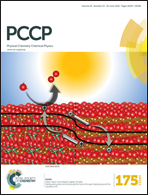Manipulating electrochemical performance through doping beyond the solubility limit†
Abstract
Improving water splitting efficiency has been the holy grail of hydrogen fuel production. Major efforts have been invested in an attempt to enhance efficiency of a common water oxidation catalyst, α-Fe2O3, through doping and alloying. Recent experiments show that higher efficiency is achieved when niobium (Nb) is added beyond the solubility limit to generate a mixture of two phases: Nb-doped and Nb-alloyed α-Fe2O3. In order to understand why adding high concentrations of Nb is beneficial, we provide a thorough first principles study of the bulk and the surface of pure, Nb-doped, and Nb-alloyed α-Fe2O3 with several surface facets and terminations. We find that the addition of Nb changes the band edge and Fermi level positions. Therefore, we propose a mechanism by which having different Nb doping levels within and above the solubility limit has an advantage: electrons and holes could separate better between doped and alloyed regions that have different band edge positions or between regions with different doping concentrations. Furthermore, the holes' driving force to oxidize water can be increased by placing on the surface the undoped or alloyed phases, since they have a lower valence band maximum. We suggest that obtaining two material phases or gradual doping can be used as a design strategy for next generation catalysts.


 Please wait while we load your content...
Please wait while we load your content...